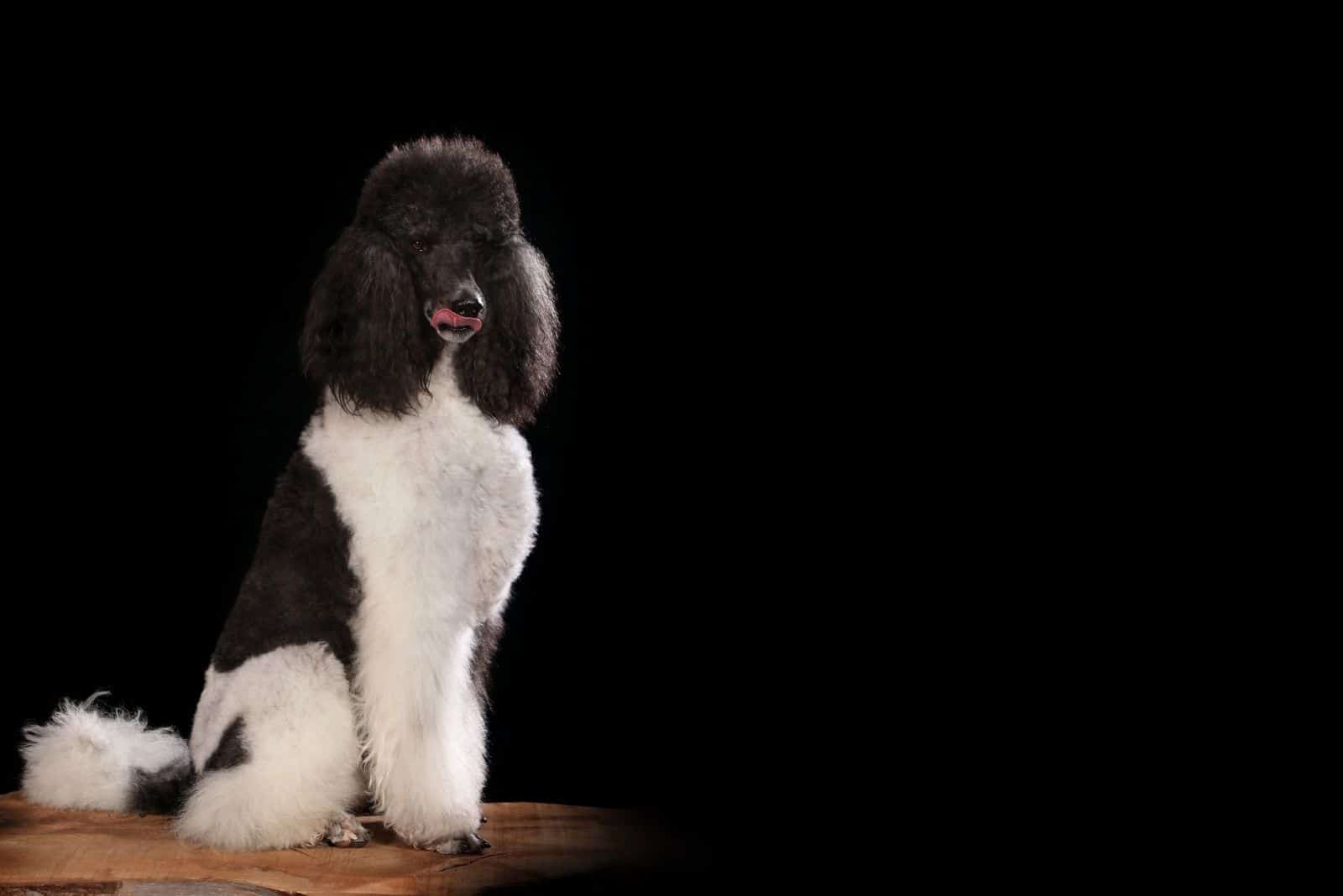The merle poodle is just like any other poodle. What makes it so different from other dogs is the poodle color it carries. These dogs have their poodle gene pool blessed (or cursed) with a specific merle gene.
The breed standard for poodles says there isn’t a specific color one poodle should have. There are many color variations, including the merle.
Not to confuse the merle color with the brindle pattern; brindles have two recessive genes, while the merle has one dominant gene.
But first, let’s check out what merle poodles are.
Later we can dive into the poodle’s gene pool and crack the code behind getting these unique-looking pups!
Getting To Know The Merle Poodle: What’s A Merle Poodle?

A merle poodle is a poodle that has its coat patterned with patches. The solid colored base has a pattern on top in the same color as the base. The pattern resembles that of a leopard.
The term “merle” refers only to the pattern rather than the color of the poodle itself. These pooches come in all poodle varieties: standard, toy, and miniature merle poodle.
Such a coat color pattern isn’t a trademark that only poodles have. The merle gene is found in many other dog breeds recognized by the AKC.
Therefore we have merle Australian Shepherds, merle Cardigan Welsh Corgis, and a merle Dachshund.
Despite being such a unique looking dog breed, there’s a lot of mixed opinions whether the merle poodle is a purebred dog or not.
Certain dog genes are responsible for a dog’s coat color and pattern. There’s a lot of controversy about whether the merle gene is completely different from the piebald gene found in Great Danes.
The piebald gene is the biggest reason why the Dane has a spotted coat.
The merle gene we’re talking about could simply be a color variation of the piebald gene or something completely different!
Some dog breeds have a merle gene that comes out naturally. However, it’s questionable if the merle gene in the poodle breed is something natural too.
It’s also quite an ethical dilemma whether to breed the merle or not.
Breeding a merle poodle can go wrong easily if not done properly. Hence the dilemma!
It takes only a single merle gene from the parents for a poodle to be born merle. But, but, but! Only a single gene. Such specificity requires careful selective breeding.
But first, what happens if the poodle ends up inheriting a double merle gene? Such cases are tragic because the poodle puppy will be born deaf and blind, along with other severe health problems.
That’s why the merle poodle is so rare and expensive!
It’s All About The Looks: What Does A Merle Poodle Look Like?

At first, the merle poodle will look just like any other poodle, with the exception of color.
A blue merle poodle is nothing more than a black poodle with grey and white patterns, making the black appear more of a blue tone.
The eye color can be completely blue or partially blue too. But still, besides the blue eyes, there are other standard colors a merle can have.
In addition, their paw pads and nose can have pink and black pigment.
Are Merle Poodles Purebred Dogs?

To this day, the opinions on whether merles are purebred or not are divided.
Some dog breeders believe that the merle pattern is a result of breeding outside the breed with dogs such as the Australian Shepherd, which have a natural merle coat.
Poodle breeders, not all of them, can become motivated by the high price of this dog breed and therefore lose their ethics. These breeders aren’t about raising purebred poodles at all!
Read Next: 7 Poodle Breeders In Michigan – Only The Best For You
Another debate about the merle poodle is about a standard poodle being bred repeatedly with an Australian Shepherd-Poodle mix. The result will give us a poodle but with a terrible merle coat.
The DNA tests will also say it’s a mixed merle poodle as opposed to a purebred poodle.
The opposed dog breeders say the merle gene was always present in the poodles, and it’s been lying under the radar for a long time.
The reason why this gene was hiding for so long lies in the fact the breeders used to use more solid color coats in the breeding process.
A hidden story lies behind gene hiding: multi-colored poodles can’t compete in any of the American Kennel Club’s dog shows, hence why the gene stayed away.
A Cryptic Merle Poodle: Have You Ever Heard Of It?

Some dog breeders believe the hiding of the merle gene happened with a little help from the Cryptic merle poodle.
But, what is a Cryptic merle poodle?
The Cryptic merle poodle is a poodle with a merle gene that doesn’t present itself, or it does present in the slightest manner, so it doesn’t change the poodle’s look.
If the merle gene is naturally occurring, it would have stayed hidden in the cryptic poodle for the entire history of breeding the merle poodle, with the exception of the last decade.
This scenario is possible because the breeders haven’t bred a merle poodle on purpose until the last ten years.
If the gene was naturally present in the cryptic poodle, it could just pass on through generations of poodles without being noticed or leaving a noticeable mark on the offspring.
Genetic testings only recently found a way to uncover the merle gene when the merle pattern isn’t visible.
When breeding a cryptic merle poodle and a standard poodle with a solid coat, the result could be merle pups.
Does Being Merle Affect The Hypoallergenic Trait?

Good news for all you guys suffering from allergies: merle poodles are hypoallergenic!
Still, some dog experts might claim that the merle poodle isn’t hypoallergenic because of its coat color; it’s because the poodles, in general, don’t usually trigger allergies.
The merles simply have all the traits, including the hypoallergenic one, like any other poodle pooch.
What Kind Of Temperament Does A Merle Have?

The other thing merles are popular for, other than their coat color, is their temperament. Merles are generally calm animals, tame and obedient.
They’re quite the people person among the dog world and love showing affection towards their owners.
Some poodle owners and breeders have connected the dots over the years and observed a correspondence between their coat and temperament.
Black merles seem to be the intelligent kind but more aloof with the strangers. Cream and apricot merle poodles are a more gentle and calm type and love to show affection.
This observation is probably because the color is usually passed down from one generation to another, while the temperament is the result of the merle puppy’s nurture and nature.
Of course, none of these rules is written in stone, and there’ll always be exceptions.
Do Merle Poodles Change Color As They Grow Older?

All dogs grow old, and that’s, unfortunately, a fact we don’t like. There will be grey hair striking out of the coat with any dog breed. The same goes for poodles.
Your merle poodle will have some grey hair as it ages, but the color will stay the same.
Merle poodles do not have a fading coat! They will stay the same from puppyhood to adulthood.
However, some poodle dogs do have a fading coat. Red, silver, and blue poodles start off black, and then they fade, losing their black color for their permanent color when they turn three.
This happens because they have a dilute gene that takes time to show up. The difference with the merle poodle is that these pooches are already diluted at birth.
What’s A Parti Poodle, And Are They The Same As Merles?

There is a small difference between these poodle types.
The Parti poodle carries a pattern of two solid colors throughout its coat. The merle poodle has a patterned coat but also a variety of dilution.
Parti poodles are generally:
• black and white
• red and white
• brown and white
White is usually the base color, while the spots are of a different color.
The base color for merles is blue-grey, and the spotting is different shades of black, blue, or grey.
To answer the question: Parti poodles aren’t the same as Merle poodles.
Breeding The Merle: The Ethical Standards

Poodle breeders are frequently in doubt when it comes to breeding merle poodles. To breed a merle or not to breed, that’s the ultimate question.
Indeed, merles are magnificent! Their coat is one of the most unique-looking in the whole canine world. But, there’s a lot of science and trouble behind getting a merle puppy.
No wonder they are so expensive! A merle colored puppy sells for over $3,000 in the USA. This is more than the average selling price of any other poodle! Breeding such puppies is a challenge not everyone wants to take.
Some breeders say it’s unethical to breed a merle poodle, while others claim there is an ethical way of breeding these puppies.
It takes extensive research, careful pairing, and considerable risk to get a merle poodle puppy.
Health Problems: Are Merle Poodles Healthy And Why Not?

A merle poodle will have a chance of a healthy life as much as any other poodle under one condition: it mustn’t be a double merle!
No matter if it comes from two merle parents, or it receives two copies of the merle gene, the puppy will end up with serious health issues.
Research has shown that when two regular merles breed, their offspring can have significant developmental health problems. This is how a double merle is born. A double merle has many eye and ear problems other poodles don’t have.
The regular merle poodle can have the same health issues other poodles have, but its general health depends on the health of the parents.
Having your breeder conduct genetics tests on the parents will ensure your puppy will have a normal and healthy life.
Here’s an interesting fact merle owners have come to learn: It appears that some merle poodles are quite sensitive to sunlight. This means the merles can be more prone to skin cancer than their poodle cousins.
However, this is still not scientifically proven, but it’s better to be safe than sorry.
Does The AKC Recognize Merle Poodles?

Surprisingly, the AKC does recognize merle poodles, and you’re able to register one with their organization. But… There’s always a “but.” A merle poodle can be accepted by the AKC only if its origin is well-known.
Even though the AKC doesn’t have a merle color category, you can still register your pup with evidence both parents were registered with the AKC.
In theory, it is possible to register your merle, but practice shows different. There are not many merle poodles with AKC registration.
Here’s why many people question whether the merle is a purebred poodle or not. If it truly is, why isn’t it registered?
The same goes for other poodle types like the parti poodle, phantom, or sable poodle.
Since there is no merle color option when registering, you can list your poodle under the multi-colored category. All in all, the registering goes under the first similar color, e.g., black and white.
Usually, dog owners register a merle under black and silver or brown and tan.
Still, competing in AKC dog shows won’t be possible for your merle since the organization allows only solid color dogs to participate. If your aspiration isn’t to become a show dog mommy or daddy, then go with the merle.
Unlike the AKC, the UKC doesn’t recognize the merle pattern in poodles at all!
The oldest dog club in the world, the UK’s official dog club, The Kennel Club (KC), also doesn’t recognize the merle pattern and doesn’t allow the registration of merle poodles.
Cracking The Code: What Lies Behind The Merle Gene
The merle gene is not a recessive or dominant gene. It’s a unique gene type of its own. You can say it’s called the incomplete dominant gene.
A recessive gene must be paired with another recessive gene to show up. A dominant gene overpowers the other genes.
Incomplete dominant genes work differently. It takes only one incomplete dominant gene to present itself.
Carefully, if two merles are paired, the offspring will be a double merle! Such puppies are at risk of battling with deafness and blindness.
That’s probably the biggest reason why some poodle breeders don’t want to breed merle puppies.
The merle gene is a gene that dilutes other colors a dog has. The difference between the merle and the dilute gene is that it doesn’t dilute the colors evenly across the dog.

Photo from:@rockyroaddoodles
What it does do is it leaves patches of dark, undiluted colors while diluting the color patches all over the dog.
That’s why the merle is so special!
Pro-merle breeders claim that, with proper genetic testings, breeding this color is possible without any risk of deafness or blindness.
The genetic testings for the merle gene are different from other testings. There are different levels of merle present in each dog. The experts say the best way to breed two merles is to match the merle gene levels.
This is a fairly new approach, and dog breeders don’t really use it. They opt for the safe, traditional choice of breeding a merle with a non-merle poodle.
Still, breeding merle and non-merle poodles may result in non-merle poodles, too, hence why the merle color is so rare. Both ways of merle production carry the risks of the puppies being born double merle.
Tips To Know When Buying A Merle Poodle

A good poodle breeder would never breed two merle poodles, even though two merles can be bred together because of the different merle levels.
Since there is no evidence such a practice is successful, no one actually breeds two merles together.
When buying a merle puppy, you will have to ensure only one of the parents is a merle. The other parent must be a non-merle.
If both are merle dogs, this dog breeder is only after money and is not invested in the health of the puppies.
Never buy a puppy that might be blind or deaf. Not because of their condition, they all need love, but because you shouldn’t support dog breeders who create double merles on purpose.
Poodles that carry other recessive genes can also carry a merle gene that can create a double merle when paired with another merle.
The poodles who can carry the hidden merle gene are:
• white
• apricot
• red
• multi-colored
How can one tell a puppy might be a double merle? Easily! Have the breeder run a color coat testing if one of the parents is a merle and the other is white, apricot, red, or parti.
In The End…

It does matter where your dog comes from. Buying from an unreliable source might mean you end up with a double merle poodle. Such dogs are prone to severe diseases of the eyes and the ears.
Of course, all dogs deserve love, but not all dog breeders deserve respect and success. If you’re not capable of handling a double merle, then just stick with standard poodle colors.
After all, it’s only the color that’s different, and we’re taught not to see color, are we?
Read Next: Poodle Feeding Chart: Maintaining The Ideal Weight


